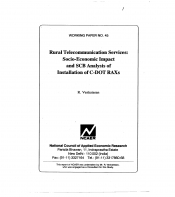Rural communication in India is on the threshold of a revolution as a result of indigenously designed rural telephone exchanges by the Centre for Development of Telematics and produced under its license by 30 manufactures.
Rural communication in India is on the threshold of a revolution as a result of indigenously designed rural telephone exchanges by the Centre for Development of Telematics and produced under its license by 30 manufactures. The NCAER study started with the question of whether the telephone is a mere luxury in rural areas or actually serves socio-economic purposes. Thus the goal was set to assess the catalytic nature of rural telecommunication services through a field survey to estimate the actual costs and benefits realized to the economy on account of setting up of C-Dot rural access exchanges (RAXs). Although there have been a few studies on the assessment of the role of information technology on economic development, these had neither used the social cost benefit analysis to estimate and translate benefits in terms of numeraire, nor used a representative sample survey to measure the impact through a study of rural exchanges already installed in different regions of the country.
Telecommunications have come a long way since F.B. Morse, the inventor of magnetic telegraphy, established the world’s first telecommunications facility in 1844. These, in turn, have been supplanted by an astoundingly vast and growing array of more sophisticated telecommunications capabilities like cellular phones, faxes, personal computer modems, and on-line data banks, etc. while these developments have been highlighted in the literature, unfortunately no study has been made on the impact of the setting-up of state of the art rural digital exchanges. The mission of this study was to clarify and quantify the socio-economic impact and the relative social costs and benefits of the provision of rural telecommunications services.







